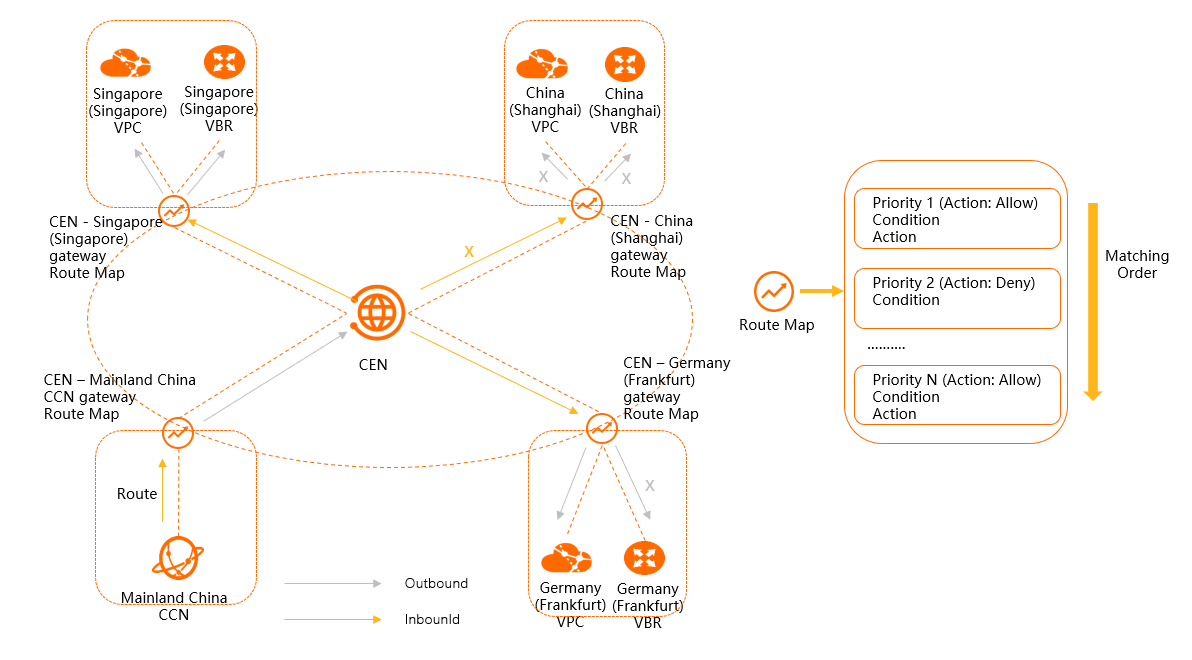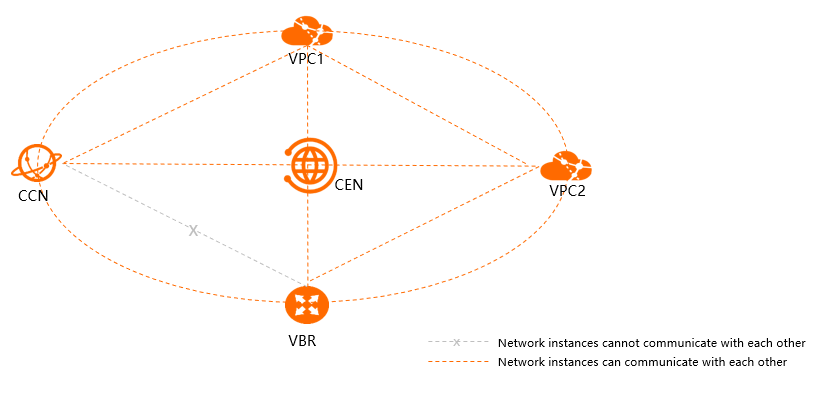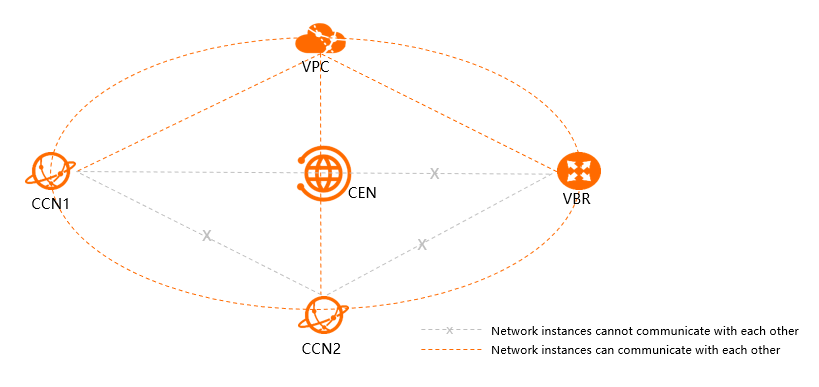Cloud Enterprise Network (CEN) supports routing policies. You can configure routing policies to filter and modify routes. This allows you to manage network communication in the cloud.
How it works
CEN has a gateway in each Alibaba Cloud region. Regional gateways are one of the basic components that CEN uses to establish communication between networks. CEN uses regional gateways to pass routes to networks that are attached to CEN.
You can configure routing policies for inbound network traffic or outbound network traffic. Each routing policy is a collection of conditional statements and execution statements. Routing policies are sorted by priority. A smaller value indicates a higher priority. Routes are matched against match conditions specified in routing policies in descending order of policy priority. Routes that meet all match conditions are permitted or denied based on the specified policy action. You can modify the priority, autonomous system (AS) path, and community value of a route that is permitted. Routes that do not match all match conditions are matched against the next routing policy by default. If a route does not match any routing policy, the route is permitted by default.

Components
| Parameter | Description |
|---|---|
| Routing Policy Priority | The priority of the routing policy.
Valid values: 1 to 100. A smaller value indicates a higher priority. You cannot specify the same priority for routing policies that apply in the same region and direction. The system compares routes against the match conditions of routing policies in descending order of priority. A smaller value indicates a higher priority. Therefore, set appropriate values to sort the routing policies in the desired order. |
| Description | Enter a description for the routing policy.
The description cannot start with |
| Region | Select the region in which the routing policy applies. |
| Direction | The direction in which the routing policy is applied.
|
| Routing Policy Action | The action to be performed on a route that meets all match conditions. The following
actions are supported:
|
| Priority of Associated Routing Policy | Specify a priority for the routing policy that you want to associate with the current
one.
|
| Parameter | Description |
|---|---|
| Source Region | The system checks whether routes are advertised from a specified region.
The system only checks whether the source regions of the routes meet the specified condition. The destination regions of the routes are not checked. |
| Source Instance IDs | The system checks whether routes are advertised from specified network instances.
The following network instance types are supported:
You can select Exclude Specified IDs to specify network instance IDs that you want to exclude. If the routes are not advertised from the specified IDs, the routes meet the condition. Otherwise, the routes fail to meet the condition. |
| Destination Instance IDs | The system checks whether routes are advertised to specified network instances. The
following network instance types are supported:
You can select Exclude Specified IDs to specify network instance IDs that you want to exclude. If the routes are not advertised to the specified IDs, the routes meet the condition. Otherwise, the routes fail to meet the condition. Note The destination instance IDs take effect only when Direction is set to Export from Regional Gateway and the destination instances are deployed in the current region.
|
| Destination Route Table | The system checks whether routes are advertised to specified route tables.
Note The destination route table IDs take effect only when Direction is set to Export from Regional Gateway and the destination route tables belong to network instances deployed in the current
region.
|
| Source Instance Type | The system checks whether routes are advertised from specified network instance types.
The following network instance types are supported:
|
| Destination Instance Type | The system checks whether routes are advertised to specified network instance types.
The following network instance types are supported:
Note The destination instance types take effect only when Direction is set to Export from Regional Gateway and the destination instance types are supported in the current region.
|
| Route Type | The system checks whether routes are of specified types. The following route types
are supported:
|
| Route Prefix | The system filters routes based on the specified route prefixes. The following match
methods are supported:
|
| AS Path | The system filters routes based on the specified AS path. The following match methods
are supported:
Note AS path is a mandatory attribute, which describes the AS numbers that a BGP route
passes through when it is advertised.
|
| Community | The system matches routes based on the community. The following match methods are
supported:
Note Community is an optional transitive attribute. You can specify a specific community
value for a specific route. Downstream routers can filter routes based on the specified
community value when routing policies are implemented.
|
| Parameter | Description |
|---|---|
| Preference | Specify a priority for the routes that are permitted.
Valid values: 1 to 100. Default value: 50. A smaller value indicates a higher priority. |
| Community | Specify a community value for routes. The following methods are supported:
|
| Appended AS Path | The AS paths that are prepended by using an action statement when regional gateways
receive or advertise routes.
For routing policies that are used in different directions, the requirements for AS
paths that are prepended are different:
|
Matching process

CEN matches routes against routing policies in match-action mode. Actions are performed after conditions are matched. The system matches routes against match conditions in descending order of routing policy priority.
- If a route meets all the match conditions in a routing policy, the specified action
is performed on the route.
- If you set Routing Policy Action to Permit, the route is permitted. By default, the system does not match a matched route against the next routing policy. However, if you set a priority for the associated routing policy, the system matches the route against the routing policy that has the specified priority. If you do not set a priority, the matching process ends.
- If you set Routing Policy Action to Deny, the route is denied. By default, the system stops matching the route against the next routing policy and the matching process ends.
- If a route does not meet a match condition specified in a routing policy, the current matching process ends and the system matches the route against the next routing policy.
- If the route meets all the match conditions specified in the next routing policy,
the action specified in the routing policy is performed on the route.
- If you set Routing Policy Action to Permit, the route is permitted. By default, the system does not match a matched route against the next routing policy. However, if you set a priority for the associated routing policy, the system matches the route against the routing policy that has the specified priority. If you do not set a priority, the matching process ends.
- If you set Routing Policy Action to Deny, the route is denied. By default, the system stops matching the route against the next routing policy and the matching process ends.
- If a route does not meet a match condition specified in a routing policy, the current matching process ends and the system matches the route against the next routing policy. The preceding processes are repeated until the system matches the route against the last routing policy.
- If the route does not meet a match condition specified in the last routing policy, the route is permitted.
Default routing policy
If a VBR or CCN instance is attached to a CEN instance, the system automatically adds a routing policy whose priority is 5000, action is Deny, and direction is Export from Regional Gateway to the regional gateway. This routing policy disallows the VBR or CCN instance from communicating with the other VBRs or CCN instances that are attached to the CEN instance. The following rules describe whether VPCs, VBRs, and CCN instances that are attached to the same CEN instance can communicate with each other.
- A VPC that is attached to a CEN instance can communicate with other VPCs, VBRs, and
CCN instances that are attached to the CEN instance.

- A VBR that is attached to a CEN instance cannot communicate with other VBRs or CCN
instances that are also attached to the CEN instance.

- A CCN instance that is attached to a CEN instance cannot communicate with VBRs or
other CCN instances that are also attached to the CEN instance.

Limits
| Resource | Limit | Adjustable |
|---|---|---|
| Number of routing policies that can be created in the Import to Regional Gateway direction for each regional gateway | 100 | Not supported |
| Number of routing policies that can be created in the Export to Regional Gateway direction for each regional gateway | 100 | Not supported |
References
The routing policy feature allows you to flexibly manage network communication in the cloud. For more information, see the following topics:
- Stop the communication between a VPC and other networks attached to a CEN instance
- Stop the communication between a VPC and a CIDR block in CEN
- Connect data centers through CEN
- Connect branches to a data center through CEN
- Configure active/standby static routes for VBRs in the same region by using route maps
- Use route maps to allow specified VPCs to communicate with each other